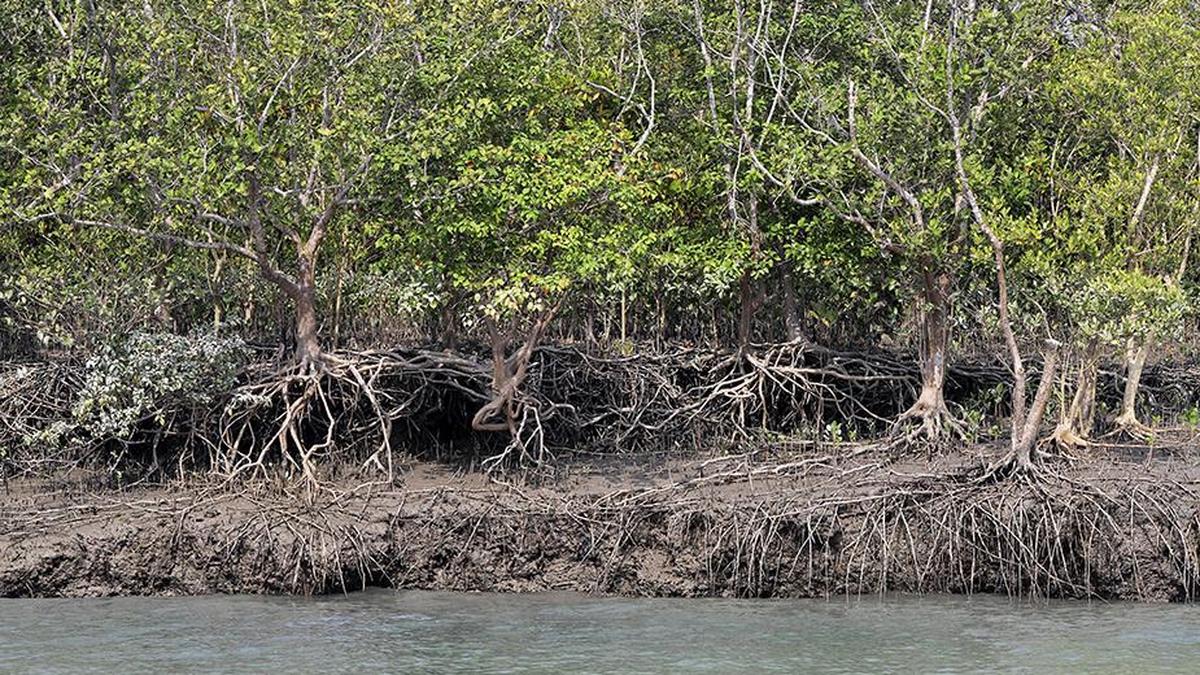
Mangroves stand on an island in the Sundarbans
| Photo Credit: AP
The Union government has taken up about 22,560 hectares of land to restore and conserve mangroves under the Mangrove Initiative for Shoreline Habitats & Tangible Incomes (MISHTI) initiative over the past two years.
Almost 85% of land, measuring 19,220 hectares, under the scheme has been acquired in Gujarat alone.
MISHTI was announced in the Union Budget for 2023-24 and was launched on June 5, 2023 to restore and promote mangroves as a unique, natural ecosystem and for preserving and enhancing the sustainability of the coastal habitats.
The objective of MISHTI is to restore mangrove forests by undertaking mangrove reforestation/afforestation measures along the coast of India, states Government of India.
The Ministry of Environment Forest and Climate Change in response to a question in the Lok Sabha in August 2025 pointed out that an area of 22,560.34 hectares has been taken up through convergence across 13 States/UTs for plantation and restoration of degraded mangroves in the year 2023-24 and 2024-25 under the scheme.
Following Gujarat, about 1060 hectares of forest land in Tamil Nadu, 837 hectares in Andhra Pradesh and 761 hectares in Odisha has been taken up for mangrove plantation.
Low acquisition in Bengal
However, only about 10 hectares of land has been acquired under the initiative in State of West Bengal, which has the largest mangrove cover in the country.
The total mangrove cover in the country stands at 4,991 sq. km out of which West Bengal alone accounts for 2,119 sq. km, which is about 42% of the mangrove cover in the country. Gujarat holds the second highest mangrove cover ranging about 1, 164 sq. km (23%), according to the latest report of Forest Survey of India (FSI) 2023.
During the ‘Mann ki Baat’ programme on Sunday, Prime Minister Narendra Modi highlighted the significance of mangrove restoration. Mr. Modi said that five years ago, the Forest Department (of Gujarat) started planting mangroves near Dholera in Ahmedabad, and “today, mangroves have spread over three and a half thousand hectares on the Dholera coast”.
“The effect of these mangroves is visible throughout the area today. The number of dolphins in the ecosystem there has risen. Crabs and other aquatic creatures have also increased in number, compared to earlier. Not only that; migratory birds are also coming here in large numbers now,” the Prime Minister added.
Ajanta Dey, of Nature Environment and Wildlife Society, an organisation that has been working for mangrove restoration in different states including West Bengal said that MISTHI was an outcome of multi-stakeholder participatory approach which was developed in West Bengal in 2020, where different schemes under MGNREGA were used for mangrove restoration.
Ms. Dey whose organisation’s model Sustainable Aquaculture in Mangrove Ecosystems (SAIME) in the Sundarbans has recently been recognised globally, said that the focus in West Bengal should be mangrove restoration instead of prioritising only new plantations.
She highlighted that the significance of mangroves in fragile ecosystems like the Sundarbans is that they act as bio-shields and the need is to have a platform involving different departments of the State government to create an environment-assisted natural regeneration of mangroves.
Published – October 27, 2025 04:25 am IST


